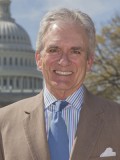By J. Brent Walker, BJC Executive Director
 It was a gorgeous, bright and crisp autumn day — November 16, 1993 — when about 200 of us gathered in the White House’s Rose Garden to witness history: the signing of the Religious Freedom Restoration Act. Surrounded by Congressional leaders of both parties and Vice President Al Gore, President Bill Clinton sat at a small desk and signed what is probably the most significant piece of religious liberty legislation of our generation.
It was a gorgeous, bright and crisp autumn day — November 16, 1993 — when about 200 of us gathered in the White House’s Rose Garden to witness history: the signing of the Religious Freedom Restoration Act. Surrounded by Congressional leaders of both parties and Vice President Al Gore, President Bill Clinton sat at a small desk and signed what is probably the most significant piece of religious liberty legislation of our generation.
Rabbi David Saperstein, director of the Religious Action Center of Reform Judaism, was effusive. “The bill enacted today,” he observed, “is the first civil rights bill in the history of America that focuses entirely on religious freedom.” Tyrone Pitts, representing the Progressive National Baptist Convention on the BJC Board of Directors, hailed RFRA as “more meaningful to us as people of God than any other legislation.” Bob Dugan, with the National Association of Evangelicals, gushed that this “historic act would gladden the heart of Thomas Jefferson who called religious liberty ‘the most sacred of all human rights.’”
I remember thinking, what a signal accomplishment! Over three and a half years had passed since the U.S. Supreme Court effectively neutered the First Amendment’s Free Exercise Clause by giving government the ability to enforce generally applicable laws that would indirectly burden someone’s exercise of religion in Employment Division v. Smith (1990). During that interregnum, more than fifty cases had been decided denying relief to religious claimants. The damage continued to mount.
I was proud that the BJC’s general counsel, Oliver “Buzz” Thomas, led a coalition of religious and civil liberties groups that helped convince Congress to pass the measure and urge a Baptist president and vice president to embrace it. The coalition — 63 members strong — spanned the religious and political spectrum from left to right: evangelicals and mainline Protestants, Jews and Muslims, Roman Catholics and Lutherans, Sikhs and Scientologists, and the ACLU and the Traditional Values Coalition put aside their theological and political disagreements and former weapons of rhetorical warfare to join forces to promote something that transcended their deep differences: religious liberty for all.
Yes, something big, something important had been accomplished. But it was never thought of as some kind of panacea. As had been the case even before 1990, religious freedom claimants would not always win; indeed, they would probably lose more often than not. This is particularly true when one’s exercise of religion would prejudice the rights or threaten the well-being of others or when the requested accommodation actually would result in the establishment of religion. But at least there would be a fighting chance — a slightly tilted playing field in favor of religious freedom — and a forum in which government would be called upon to withstand strict judicial scrutiny when it tried to interfere with religious practice.
The ensuing two decades, however, have brought developments that most of us — president and vice president, members of Congress, the coalition, and legal scholars — did not foresee.
We were confident that RFRA would survive a constitutional challenge. But the Supreme Court struck down RFRA as applied to state and local governments in City of Boerne v. Flores (1997), even though the law continues to apply with full force to the federal government (Several state religious liberty laws and the federal Religious Land Use and Institutionalized Persons Act of 2000 provide additional protection.) Lower federal courts interpreted RFRA to require the religious practice in question be mandated by one’s religion and central to one’s belief system, considerably narrowing RFRA’s protections. (Congress later amended RFRA to make clear that religious motivation, not compulsion or centrality, is what’s required.) Perhaps most dishearteningly, the grand coalition’s good will generated by cooperation has dwindled. The culture wars over the past 20 years made this result almost inevitable. But attempts to extend RFRA beyond its intended application and disagreement over RFRA’s interpretation in the area of civil rights and health care has strained much of the good will and vitiated any unanimity of opinion on RFRA’s workings in our judicial system.
The upcoming RFRA anniversary celebration and symposium (described in the October 2013 “Hollman Report”) will provide a welcomed forum for understanding differences, seeking agreements and hopefully launching a new era of civility and cooperation as we try to balance religious liberty with the rights of others and the well-being of society generally.
For more on RFRA:
Visit BJConline.org/RFRA or read “RFRA at 20: a retrospective” by General Counsel K. Hollyn Hollman, from the October 2013 Report from the Capital.
From the October 2013 Report from the Capital. Click here for the next article.
Click here to view the entire magazine as a PDF.





